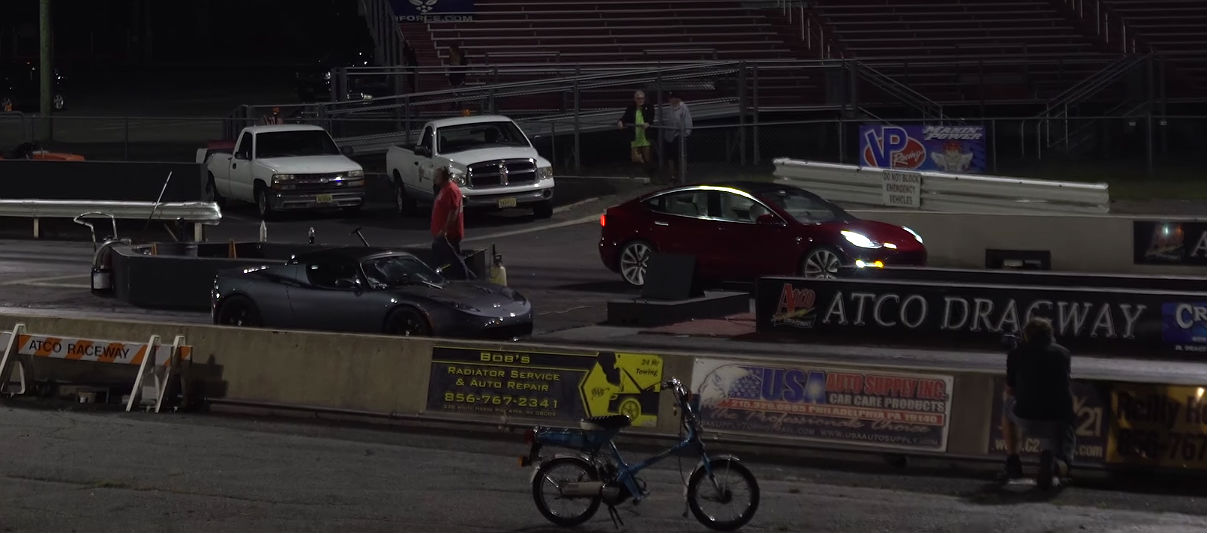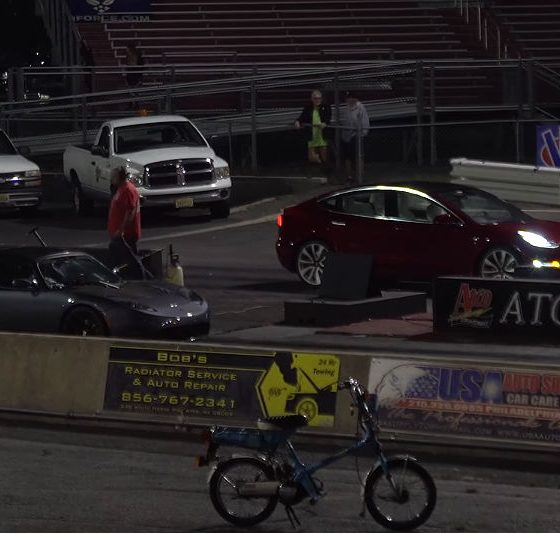

Lifestyle
Tesla Roadster Sport comes out of retirement to race the Model 3 Performance
Some vehicles will forever hold a special place in people’s hearts. For the Tesla community, that car would be the original Roadster, a car that broke the mold of conventional electric vehicles when it was released. With the Roadster, Tesla proved that electric cars did not have to look and perform like glorified golf carts — they can be fast, sleek, and sexy too.
The original Roadster garnered a lot of awards during its time. On October 27, 2009, for one, the Tesla Roadster set a world distance record for production electric cars, traveling 501 km (311 miles) on a single charge. In March 2010, the sports car also became that first electric vehicle to win the Monte Carlo Alternative Energy Rally, with Formula One driver Erik Comas driving an Arctic White Roadster to dominate the three-day, 1,000-km (620-mile) event.
Tesla released the Roadster Sport in 2009, as a top trim for the electric sports car. In its review of the vehicle, Car and Driver noted that the Roadster Sport hit 60 mph in just 4 seconds, thanks to its powerful AC permanent-magnet synchronous electric motor that produces instant torque. With its 122 mph top speed, 288 bhp of power, and 295 lb-ft of torque, the Roadster Sport was capable of sucking the breath out of unassuming passengers.
Tesla only sold about 2,450 Roadsters during the vehicles’ entire run from 2008-2012. After the Roadster, Tesla focused its efforts on developing and refining the Model S sedan, a vehicle that could very well be the most important car of the decade. Following the Model S was the Model X SUV, and after that came the Model 3, the company’s first attempt at a mass-market car. Tesla passed through “production hell” with the Model 3, though the company was able to power through its difficulties this year. Elon Musk recently noted that Tesla is now at a point when it has no problem building 5,000 Model 3 a week — more than twice the number of original Roadsters the company produced over four years.
The Model 3 Performance is the top trim of Tesla’s latest vehicle. Being powered by larger and more energy-dense 2170 battery cells, the Model 3 Performance is Tesla’s first track capable car. Equipped with two electric motors that produce a combined 450 hp and 471 lb-ft of torque, the high-performance electric sedan has an impressive 0-60 mph time of 3.5 seconds (eventually updated to 3.3 seconds by Tesla), a top speed of 155 mph, and a range of 310 miles per charge.
In sheer specs alone, the Model 3 Performance — the most conservative among Tesla’s Performance-branded vehicles — outguns the original Roadster. As a video of a race between the two cars shows, though, the original Tesla Roadster is still incredibly quick despite its age. The race between Tesla’s past and present electric cars was held at the Atco Dragway in NJ, where two neophyte drivers christened the drag strip with the rather rare matchup.
Thanks to the raw power of its electric motor, as well as the reaction time of the Model 3 Performance’s driver, the Tesla Roadster Sport established an early lead during the bout. Midway through the quarter-mile, though, the Model 3 Performance started catching up. Both vehicles were neck-and-neck until the end of the race. The Model 3 Performance crossed the quarter-mile mark in 11.838 seconds at 114.02 mph, while the Tesla Roadster Sport completed the run in 12.959 seconds at 101.13 mph. Thus, despite getting the jump over the newer car off the line, the Roadster Sport ultimately bowed down to the Model 3 Performance by 0.6623 seconds.
Its loss to the Model 3 Performance aside, it’s difficult to not remain impressed by the Tesla Roadster Sport. The car, after all, is equipped with battery and powertrain technology that has since been improved by Tesla. Despite this, the vehicle was still able to perform the way Elon Musk wanted it to — as an electric sports car that can stand toe-to-toe with some of the best high-performance cars in the market.
Watch the original Tesla Roadster Sport battle the Model 3 Performance in the video below.

Lifestyle
Tesla Model S Plaid battles China’s 1500 hp monster Nurburgring monster, with surprising results
There is just something about Tesla’s tuning and refinement that makes raw specs seem not as game-changing.

The Tesla Model S Plaid has been around for some time. Today, it is no longer the world’s quickest four-door electric sedan, nor is it the most powerful. As per a recent video from motoring YouTube channel Carwow, however, it seems like the Model S Plaid is still more than a match for some of its newer and more powerful rivals.
The monster from China
The Xiaomi SU7 Ultra is nothing short of a monster. Just like the Model S Plaid, it features three motors. It also has 1,548 hp and 1,770 Nm of torque. It’s All Wheel Drive and weighs a hefty 2,360 kg. The vehicle, which costs just about the equivalent of £55,000, has been recorded setting an insane 7:04.957 at the Nurburgring, surpassing the previous record held by the Porsche Taycan Turbo GT.
For all intents and purposes, the Model S Plaid looked outgunned in Carwow’s test. The Model S Plaid is no slouch with its three motors that produce 1,020 hp and 1,420 Nm of torque. It’s also a bit lighter at 2,190 kg despite its larger size. However, as the Carwow host pointed out, the Model S Plaid holds a 7:25.231 record in the Nurburgring. Compared to the Xiaomi SU7 Ultra’s record, the Model S Plaid’s lap time is notably slower.
Real-world tests
As could be seen in Carwow’s drag races, however, Tesla’s tech wizardry with the Model S Plaid is still hard to beat. The two vehicles competed in nine races, and the older Model S Plaid actually beat its newer, more powerful counterpart from China several times. At one point in the race, the Xiaomi SU7 Ultra hit its power limit due to its battery’s temperature, but the Model S Plaid was still going strong.
The Model S Plaid was first teased five years ago, in September 2020 during Tesla’s Battery Day. Since then, cars like the Lucid Air Sapphire and the Xiaomi SU7 Ultra have been released, surpassing its specs. But just like the Model Y ended up being the better all-rounder compared to the BYD Sealion 7 and the MG IM6, there is just something about Tesla’s tuning and refinement that makes raw specs seem not as game-changing.
Check out Carwow’s Model S Plaid vs Xiaomi SU7 drag race video below.
Lifestyle
500-mile test proves why Tesla Model Y still humiliates rivals in Europe
On paper, the BYD Sealion 7 and MG IM6 promised standout capabilities against the Model Y.

BYD is seeing a lot of momentum in Europe, so much so that mainstream media has taken every opportunity to argue that the Chinese automaker has beaten Tesla in the region. But while BYD sales this year in Europe are rising and Tesla’s registrations remain challenged, the raw capabilities of vehicles like the Model Y are difficult to deny.
This was highlighted in a 500-mile challenge by What Car? magazine, which showed that the new Tesla Model Y is more efficient, cheaper to run, and more reliable than rivals like the BYD Sealion 7, and even the nearly 400 KW-charging MG IM6.
Range and charging promises
On paper, the BYD Sealion 7 and MG IM6 promised standout capabilities against the Model Y. The Sealion 7 had more estimated range and the IM6 promised significantly faster charging. When faced with real-world conditions, however, it was still the Model Y that proved superior.
During the 500-mile test, the BYD nearly failed to reach a charging stop, arriving with less range than its display projected, as noted in a CarUp report. MG fared better, but its charging speeds never reached its promised nearly-400 kW charging speed. Tesla’s Model Y, by comparison, managed energy calculations precisely and arrived at each stop without issue.
Tesla leads in areas that matter
Charging times from 25% to 80% showed that the MG was the fastest at 17 minutes, while Tesla and BYD were close at 28 and 29 minutes, respectively. Overall efficiency and cost told a different story, however. The Model Y consumed 19.4 kWh per 100 km, compared to 22.2 for MG and 23.9 for BYD. Over the full trip, Tesla’s charging costs totaled just £82 thanks to its supercharger network, far below BYD’s £130 and MG’s £119.
What Car? Magazine’s testers concluded that despite BYD’s rapid sales growth and the MG IM6’s seriously impressive charging speeds, Tesla remains the more compelling real-world choice. The Model Y just offers stability, efficiency, and a proven charging infrastructure through its Supercharging network. And as per the magazine’s hosts, the Model Y is even the cheapest car to own among the three that were tested.
Watch What Car? Magazine’s 500-mile test in the video below.
Lifestyle
Tesla Cybertruck slapped with world’s least intimidating ticket, and it’s pure cringe
One cannot help but cringe and feel second-hand embarrassment at the idea of a person just driving around with a stack of these babies.

A Cybertruck parked at Stanford Shopping Center in California was recently hit with what might be the most try-hard piece of paper ever slipped under a wiper blade: a “fake citation” accusing the driver of supporting a “fascist car.”
The note, shared on X by Tesla staff program manager Ryan Torres, quickly made the rounds on X, where it quickly gained attention as an example of how not to protest.
The world’s least intimidating ticket
According to the citation, the supposed “violation” was “driving a fascist car.” The remedial action? Take the bus, call an Uber, or ride a bike. The note also dubbed Elon Musk a “chainsaw-wielding Nazi billionaire.” Now, protests against Tesla and Elon Musk have become commonplace this year, but one cannot help but cringe and feel second-hand embarrassment at the idea of a person just driving around with a stack of fake anti-Tesla/Musk citations.
Torres pointed out the irony himself in his post on X. Tesla currently employs over 140,000 Americans, and SpaceX has put the U.S. firmly back at the top of space technology. As Torres put it, maybe the person behind the world’s least intimidating ticket should “read a book on innovation before vandalizing” other people’s property.
Peak performative clownery
Not to mention that the fake ticket’s logic collapses under its own weight. EVs like the Cybertruck are literally designed to reduce emissions, not “destroy the economy.” If anything, Tesla has bolstered the United States’ economy by fueling jobs in engineering, manufacturing, and clean energy. It’s not the first time a Tesla has been the target of vandalism or politically charged notes, but this one stands out for sheer cringe value.
Torres summed it up neatly: “Peak clownery.” On that point, at least, the citation earns full marks. In a way, though, perhaps cringe fake tickets are not as bad as the literal firebombs that were being thrown at Tesla stores and cars earlier this year because some critics were gleefully misinformed about Elon Musk.








